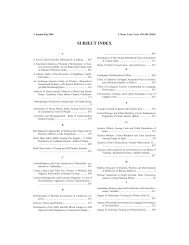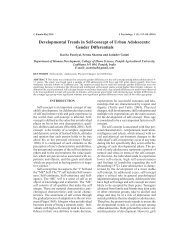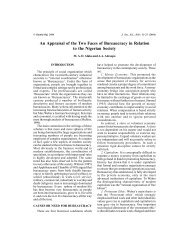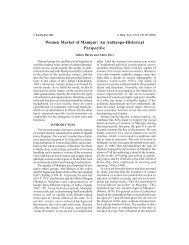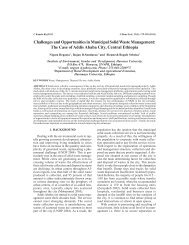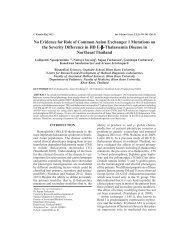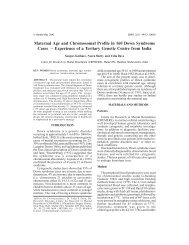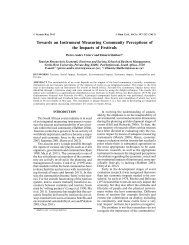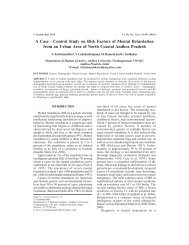Views on the Origins, Structure and Hierarchy of Some Niger Delta ...
Views on the Origins, Structure and Hierarchy of Some Niger Delta ...
Views on the Origins, Structure and Hierarchy of Some Niger Delta ...
Create successful ePaper yourself
Turn your PDF publications into a flip-book with our unique Google optimized e-Paper software.
VIEWS ON THE ORIGINS, STRUCTURE AND HIERARCHY<br />
<strong>the</strong> Isoko people. Eg<strong>on</strong>wa (1994) links some<br />
<strong>Niger</strong> <strong>Delta</strong> mud sculpture styles to those <strong>of</strong> Ijo<br />
or Benin descent. Dark (1973) tells us about<br />
<strong>the</strong> two discernable styles <strong>of</strong> Benin mud sculpture,<br />
which reflects <strong>the</strong> distincti<strong>on</strong>s William Fagg<br />
made. They are <strong>the</strong> court <strong>and</strong> plebeian styles.<br />
Ben-Amos (1973) made a remark <strong>on</strong> <strong>the</strong> relati<strong>on</strong>ship<br />
between court <strong>and</strong> plebeian styles. According<br />
to her, imagery <strong>and</strong> <strong>the</strong> spatial compositi<strong>on</strong><br />
possessed by <strong>the</strong>se sculptures are closely<br />
related to <strong>the</strong> Benin court art. Cited by Peek (1976)<br />
in his sacred “Mud sculptures”, Ben-Amos also<br />
suggests that Olokun at least by name may be<br />
Yoruba in Origin.<br />
J<strong>on</strong>es <strong>and</strong> Bradbury (1975) see Owerri as <strong>the</strong><br />
stimulus, resulting in <strong>the</strong> Edo <strong>and</strong> western Igbo<br />
elaborate mud sculptures. In <strong>the</strong> same document,<br />
Bradbury (1975) also points out that <strong>the</strong> c<strong>on</strong>cept<br />
<strong>of</strong> mud sculptures were relatively recent introducti<strong>on</strong>s<br />
in Benin City.<br />
Benin Historical <strong>Origins</strong> <strong>of</strong> <strong>Some</strong> <strong>of</strong> <strong>the</strong><br />
Menti<strong>on</strong>ed Cultures<br />
Most cultures in <strong>the</strong> <strong>Niger</strong> <strong>Delta</strong>, particularly<br />
those located in <strong>Delta</strong> State, trace <strong>the</strong>ir origins to<br />
Benin. These cultures include Urhobo, Isoko,<br />
Ukwuani, Western Igbo <strong>and</strong> some Ijo groups.<br />
<strong>Some</strong> <strong>of</strong> <strong>the</strong>se claims date as far back as between<br />
<strong>the</strong> fourteen to <strong>the</strong> sixteenth century A. D. The<br />
reas<strong>on</strong>s for <strong>the</strong>se similar dates are diverse.<br />
Perhaps, that was <strong>the</strong> period when <strong>the</strong> Benin Obas<br />
(kings) exerted <strong>the</strong>ir authority <strong>and</strong> sovereignty<br />
over <strong>the</strong>ir neighbours.<br />
Egharevba (1968) in his book “A Short<br />
History <strong>of</strong> Benin” c<strong>on</strong>firms <strong>the</strong> Benin lordship<br />
over <strong>the</strong>se cultures. He claims that<br />
…<strong>the</strong> early peoples <strong>of</strong> Ishan <strong>and</strong> Afenmai<br />
Divisi<strong>on</strong>s, <strong>the</strong> Eka <strong>and</strong> Ibo – speaking peoples<br />
<strong>of</strong> <strong>the</strong> west bank <strong>of</strong> <strong>the</strong> <strong>Niger</strong>, Aboh, <strong>the</strong> Urhobo,<br />
Isoko <strong>and</strong> <strong>the</strong> people <strong>of</strong> Onitsha are all<br />
emigrants from Benin.<br />
Speaking <strong>on</strong> <strong>the</strong> Urhobo, Otite (2003)<br />
however believes that at <strong>the</strong> end <strong>of</strong> <strong>the</strong> Ogiso<br />
(rulers) dynasty, many Urhobo <strong>and</strong> o<strong>the</strong>r Edo<br />
groups left Udo in different directi<strong>on</strong>s. Ikimi<br />
(1984) attests to <strong>the</strong> Benin origin <strong>of</strong> some Urhobo<br />
settlements such as Ughelli, Ogor, Agb<strong>on</strong>,<br />
Agbarho, Agbarha, Abraka, Oghara, Okpe, Olomu,<br />
Uvwie, Effuruntor <strong>and</strong> Uwhenru. This view is<br />
also supported by Adjara <strong>and</strong> Omokri (1997). Ekeh<br />
(2006) went ahead to classify into three stages<br />
<strong>the</strong> likely periods <strong>of</strong> Urhobo history. They inc-<br />
lude: Ancient Times, Middle Ages <strong>and</strong> Modern<br />
Times.<br />
The origins <strong>of</strong> <strong>the</strong> western Igbo clans are not<br />
viewed differently. Henders<strong>on</strong> (1972) recalls that<br />
<strong>the</strong> founders <strong>of</strong> Onitsha <strong>and</strong> Agbor were from<br />
Benin. Beier (1963) even attaches <strong>the</strong> historical<br />
c<strong>on</strong>necti<strong>on</strong>s between Agbor <strong>and</strong> Benin to<br />
Ezechima who was said to be <strong>on</strong>e <strong>of</strong> <strong>the</strong> s<strong>on</strong>s <strong>of</strong><br />
<strong>the</strong> Oba <strong>of</strong> Benin. Isichei (1977) quoting Osu,<br />
points at some western Igbo communities as<br />
originating from Benin. They include: Onitsha –<br />
Ol<strong>on</strong>a, Onitsha Ugbo, Issele-Ukwu <strong>and</strong> Agbor.<br />
Onwuejeogwu (1981) however supports <strong>the</strong><br />
claim <strong>of</strong> Benin origin <strong>of</strong> some major western Igbo<br />
communities <strong>of</strong> Ossissa, Onitsha, Aboh <strong>and</strong><br />
Agbor.<br />
As regards <strong>the</strong> Ukwuani group, Okolugbo<br />
(1978) submits <strong>the</strong> following view:<br />
…many <strong>of</strong> <strong>the</strong> Ukwuani clans trace <strong>the</strong>ir<br />
origins to Benin. The first wave <strong>of</strong> migrati<strong>on</strong>s is<br />
represented by Umukashiade, Ebedei <strong>and</strong><br />
Akarai clans <strong>and</strong> <strong>the</strong>ir <strong>of</strong>fshoots, <strong>the</strong> sec<strong>on</strong>d was<br />
brought Abara, Uto-Oku, Umu-barauchi, Nd<strong>on</strong>i,<br />
Onya <strong>and</strong> Adai <strong>and</strong> <strong>the</strong> third which led to <strong>the</strong><br />
rise <strong>of</strong> Aboh Kingdom, came from Benin.<br />
Writing <strong>on</strong> <strong>the</strong> Ijo group, Le<strong>on</strong>ard (1968)<br />
suggests a break away <strong>of</strong> <strong>the</strong> group from Benin<br />
as follows;<br />
…In a way, it is tolerably evident <strong>the</strong> first <strong>of</strong><br />
all originated from <strong>the</strong> latter <strong>and</strong> <strong>the</strong>n after<br />
breaking away from <strong>the</strong>m, remained under <strong>the</strong><br />
sovereignty <strong>of</strong> <strong>the</strong>ir king… <strong>and</strong> as time went <strong>on</strong><br />
<strong>and</strong> synchr<strong>on</strong>ously with <strong>the</strong> dwindling power <strong>of</strong><br />
<strong>the</strong> present m<strong>on</strong>archy this c<strong>on</strong>necti<strong>on</strong> loosened<br />
<strong>and</strong> lessened…<br />
Alagoa <strong>and</strong> Kiebel (1989) comment <strong>on</strong> <strong>the</strong><br />
claims <strong>of</strong> Benin origin am<strong>on</strong>gst some Ijo clans <strong>of</strong><br />
<strong>the</strong> <strong>Delta</strong> <strong>and</strong> Ondo States. Their claims were<br />
based <strong>on</strong> some reports written in <strong>the</strong> 1930s which<br />
indicate that five clans <strong>of</strong> western Ijo, Benin,<br />
Tarakiri, Kabowei, Kumbowei <strong>and</strong> Mein menti<strong>on</strong>ed<br />
Benin as <strong>the</strong>ir origin.<br />
Likely Hierarchical C<strong>on</strong>ceptual <strong>Origins</strong><br />
Am<strong>on</strong>gst <strong>the</strong> Menti<strong>on</strong>ed Cultures<br />
49<br />
Most Benin brass plaques classified by Fagg<br />
in <strong>the</strong> sixteenth century show traces <strong>of</strong> hierarchy.<br />
The c<strong>on</strong>cept <strong>of</strong> hierarchy in African art, however<br />
pre-dates <strong>the</strong> fifteenth to eighteenth centuries.<br />
Dates associated with <strong>the</strong> hierarchical trait goes<br />
bey<strong>on</strong>d three thous<strong>and</strong> years ago. Historically, it<br />
is evident that ancient Egyptian <strong>and</strong> Sudanese




